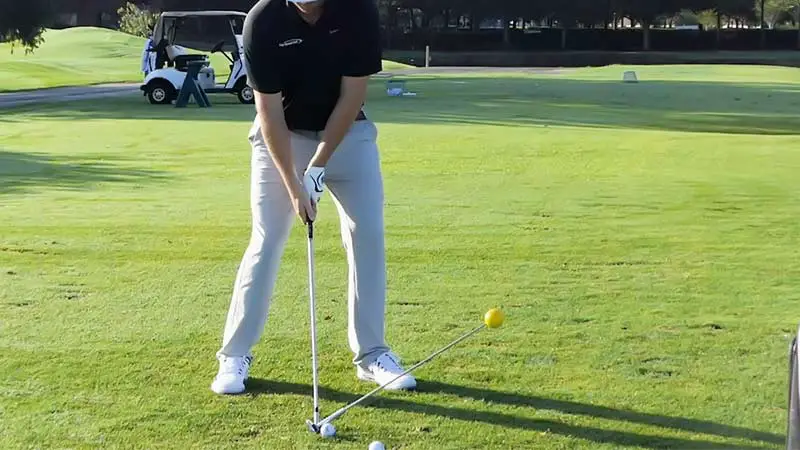Have you ever wondered how professional golfers achieve those awe-inspiring, long drives that seem to defy the laws of physics?
The secret lies in the skillful art of compressing a golf ball. Compressing the ball is not just about brute force; it’s a technique that combines precision and timing to optimize your shots. So, how to compress a golf ball?
In this guide, we’ll delve into the intricacies of compressing a golf ball, breaking down the mechanics and providing step-by-step instructions to help you enhance your game. We’ll also discuss why you should consider compressing your golf ball for longer shots.
Whether you’re a novice golfer looking to improve your swing or an experienced player aiming for that extra yardage, mastering the compression technique can make a significant difference.
Get ready to unlock the secrets behind powerful drives and take your golfing prowess to new heights.
How To Compress A Golf Ball?
Compressing a golf ball is a crucial skill that can significantly impact your game, especially when it comes to achieving longer drives.
Here, we’ll break down the process step by step, providing insights into the science behind ball compression and practical tips to incorporate into your swing.
The Science Behind Compression
Before diving into the how-to, let’s explore the science behind compressing a golf ball. Golf balls are designed with various layers, including a core, mantle, and cover.
When you strike the ball, energy is transferred from the clubhead to the ball, causing it to compress. This compression and subsequent decompression contribute to the ball’s flight characteristics.
The core, often made of rubber, is a critical element in compression. A softer core allows for more compression, resulting in higher launch angles and increased distance. Understanding your golf ball’s compression rating, usually indicated on the packaging, is essential.
Golfers with slower swing speeds may benefit from a lower compression ball, while those with faster swings may find higher compression more suitable.
Steps to Compressing a Golf Ball
To compress a golf ball, follow the steps given below:
Proper Setup
To lay the foundation for effective compression, start with a solid setup. Ensure your feet are shoulder-width apart, fostering stability, and distribute your weight evenly. Position the ball just inside your left heel (for right-handed golfers) to optimize your stance.
A proper setup establishes the groundwork for a successful swing. Check your alignment, grip, and posture to create a platform that sets the stage for optimal compression.
Correct Ball Position
The placement of the golf ball is critical for achieving the desired compression. Experiment with positioning it just in front of the center of your stance, a sweet spot for many golfers. Finding the ideal position enhances your ability to compress the ball effectively.
Ball position influences launch angle and spin rate. Fine-tune your setup by experimenting with ball placement during practice sessions, noting the impact on your swing dynamics.
Understanding Your Golf Club
Each club in your bag has unique characteristics that influence ball compression. Differentiating between woods and irons is crucial.
Recognize that woods, with larger clubheads and lower lofts, interact with the ball differently than irons. Knowing your clubs is key to optimizing compression.
Take time to familiarize yourself with the nuances of each club. Understand how loft, clubhead size, and shaft flexibility contribute to compression. This knowledge empowers you to make informed choices based on the shot at hand.
Takeaway and Backswing
Initiate your swing with a smooth takeaway, setting the tone for the entire sequence. During the backswing, focus on a gradual turn of your shoulders and a slight hinge of your wrists. This controlled motion prepares your body for the compression phase during the downswing.
The takeaway and backswing lay the groundwork for a well-coordinated downswing. Emphasize a synchronized motion to optimize clubhead speed and trajectory, key elements in achieving effective compression.
Transition and Downswing
The transition from backswing to downswing is a pivotal moment in the compression process. Shift your weight from the right side to the left, initiating the downswing. Maintain a cocked wrist position to store energy, ensuring a powerful and controlled release through impact.
Smooth transitions and a well-timed downswing are essential for maximizing compression. Practice transitioning seamlessly to capitalize on the stored energy, translating it into increased ball speed.
Impact Position
Achieving the right impact position is paramount for effective compression. Ensure your hands are slightly ahead of the clubhead, facilitating a descending blow on the ball. This imparts the desired spin for enhanced control and increased distance.
Focus on achieving a consistent impact position to promote optimal compression. Experiment with minor adjustments to find the position that maximizes both power and accuracy in your shots.
Follow Through
A complete follow-through is the culmination of a well-executed swing. Allow your body to rotate fully, and extend your arms toward the target. A balanced finish signifies not only a successful swing but also optimal compression.
The follow-through is more than just a visual flourish. It ensures that your energy is efficiently transferred to the ball. Emphasize a full and balanced follow-through to enhance the overall effectiveness of your compression technique.
Practical Tips for Improvement
Consistent practice is key to mastering the art of compression. Regularly visit the driving range to refine your technique and build muscle memory. Record your swings and analyze them. Look for any deviations from the recommended technique.
This visual feedback can be invaluable for identifying areas that need improvement. Try different golf ball types and compression ratings. Not all golfers have the same swing speed, so finding the right ball for your game can make a significant difference.
Why Compress a Golf Ball?

Compressing a golf ball is a fundamental aspect of achieving optimal distance, accuracy, and control in your shots. Understanding why compression matters can significantly impact your overall performance on the golf course.
Increased Distance
Compressing the golf ball efficiently allows it to spring off the clubface with greater speed. This increased speed translates into longer distances, a crucial advantage, especially on longer holes.
Optimized Launch Conditions
Proper compression contributes to achieving the optimal launch angle and spin rate. This combination is essential for maximizing carry distance and ensuring the ball lands and rolls as desired.
Enhanced Accuracy
Compression influences the trajectory and accuracy of your shots. A well-compressed ball is more likely to follow the intended flight path, reducing the likelihood of errant shots and improving overall shot dispersion.
Better Control
The ability to compress the ball effectively provides golfers with better control over their shots. This control is particularly valuable when navigating around hazards or when precision is crucial, such as on approach shots to the green.
Consistent Shotmaking
Mastering compression contributes to a more consistent ball flight. Consistency is key in golf, and a repeatable compression technique leads to predictable shot outcomes, allowing golfers to better strategize their play.
Optimal Use of Club Technology
Different golf clubs are designed with specific characteristics, and proper compression ensures that you’re making the most of your club’s technology. Understanding how each club interacts with the ball helps you tailor your approach for various situations on the course.
Efficient Energy Transfer
Compressing the ball efficiently enables a more effective transfer of energy from the club to the ball. This ensures that the energy generated by your swing is utilized to its fullest extent, resulting in powerful and controlled shots.
Adaptability to Course Conditions
Golfers who can adjust their compression technique based on course conditions, such as wind or uneven lies, have a strategic advantage. The ability to adapt compression to varying situations enhances a golfer’s overall versatility.
Mastering the skill of compressing a golf ball is about optimizing the performance of both your swing and the equipment you use. It is a dynamic interplay of technique, club selection, and adaptability that can lead to improved outcomes on the course.
FAQs
Why is compressing a golf ball important?
Compressing a golf ball is crucial for achieving optimal distance, accuracy, and control in your shots. It maximizes energy transfer, leading to longer drives and improved overall performance on the golf course.
How do I know which golf ball compression is right for me?
Choosing the right compression depends on your swing speed. Golfers with slower swings may benefit from lower compression balls, while those with faster swings generally prefer higher compression. Experimenting with different compression ratings can help you find the ball that suits your game.
Can I compress a golf ball with any type of club?
Different clubs interact with the ball in unique ways. Woods and irons, for example, have distinct characteristics. Understanding your clubs and how they influence compression allows you to tailor your approach for various shots on the course.
Are there specific drills to improve my golf ball compression?
Yes, several drills can help enhance your compression technique. Focus on proper setup, practice controlled takeaways, and emphasize a smooth transition in your downswing.
Working with a golf professional or using video analysis can provide valuable feedback to refine your skills.
Does ball position affect compression, and how should I position it?
Absolutely, ball position significantly influences compression. For most golfers, placing the ball just in front of the center of the stance is ideal. Experiment with small adjustments during practice to find the position that optimizes compression for your swing and desired ball flight.
Conclusion
Mastering the art of compressing a golf ball is a game-changer for any golfer seeking improved performance on the course.
By understanding the mechanics and implementing the techniques outlined in this guide, you can elevate your game and achieve those coveted long drives with greater consistency. Remember, it’s not just about sheer power but a harmonious blend of precision and timing.
As you practice and integrate these principles into your swing, you’ll find yourself not only compressing the ball more effectively but also enjoying a newfound confidence in your ability to control and enhance your shots.
So, head to the driving range, put these tips into action, and watch as your golf game reaches new levels of excellence. May your drives be powerful, your accuracy impeccable, and your time on the course truly rewarding.








Colin McCarthy